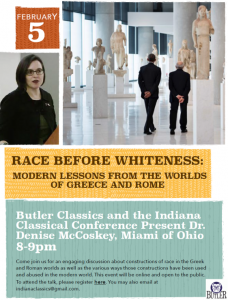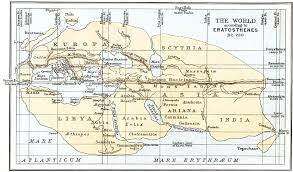 On February 5th, Dr. Denise McCoskey, hosted by Butler Classics and the Indiana Classical Conference, gave a wonderful and eye-opening lecture on the topic of “Race before Whiteness: Modern Lessons from the World of Greece and Rome.” Dr. McCoskey is a decorated professor currently teaching at Miami University in Ohio. She teaches a wide range of classes about classical societies, and her area of expertise is women in antiquity. She has written extensively on race and gender in the ancient world and is currently working on a project about American Slavery and how it is portrayed in nineteenth-century Latin schoolbooks. In case you missed this engaging and illuminating discussion, we’ve included a brief overview of her lecture, which provided a general introduction to the ways that Greeks and Romans conceptualized racial differences and also explored the ways that these conceptions have been used and abused in the modern world.
On February 5th, Dr. Denise McCoskey, hosted by Butler Classics and the Indiana Classical Conference, gave a wonderful and eye-opening lecture on the topic of “Race before Whiteness: Modern Lessons from the World of Greece and Rome.” Dr. McCoskey is a decorated professor currently teaching at Miami University in Ohio. She teaches a wide range of classes about classical societies, and her area of expertise is women in antiquity. She has written extensively on race and gender in the ancient world and is currently working on a project about American Slavery and how it is portrayed in nineteenth-century Latin schoolbooks. In case you missed this engaging and illuminating discussion, we’ve included a brief overview of her lecture, which provided a general introduction to the ways that Greeks and Romans conceptualized racial differences and also explored the ways that these conceptions have been used and abused in the modern world.

Dr. McCoskey began her presentation by defining race as an ideological framework used to organize perceived human variation. She explains that our modern idea of race is very different from what Greeks and Romans would have thought about race. She also noted that the Greeks and Romans would not have thought of themselves as white (if, for example, you suggested to an ancient Roman that they belonged in the same racial category as a German, they would have vehemently disagreed). She goes on to explain that Greeks and Romans believed that genetic variations were a result of the geographic location of where you were from and how much sunlight that place would receive (as described in the Hippocratic essay On Airs, Waters, and Places). Ancient peoples also placed their own civilizations (oikumene) at the center of the world (exemplified in the map of Eratosthenes) and viewed themselves as superior because of their geographic location.
Dr. McCoskey explained how the concept of slavery in the ancient world was very different than the colonial slavery that we are familiar with. A key difference is that people weren’t enslaved on the basis of race. Instead slaves were often prisoners of war or people who couldn’t pay their debts.

When the Ancient Greek and later Roman empires dissolved into smaller countries and kingdoms, their way of thinking about race dissolved too. Their ancient ways of thinking were later rediscovered and adopted by Europeans during the age of scientific exploration. Because the scientists lacked the context needed to understand the way that ancient people thought, they interpreted ancient ideas with modern minds. This misunderstanding (among other things) led to a pseudoscience called craniometry that used the shape of skulls to identify which races were more evolved than others. This pseudoscience was used to justify the idea that people from Africa were better suited to be enslaved because their skull shape proved that they were less evolved than Europeans were. Craniometry has since been debunked, but Dr. McCoskey notes that a dangerous amount of people still use it as a justification for white supremacy in the modern era.
At the end of her talk, Dr. McCoskey reminded her audience that, as classicists, we have to be better, more informed, and more aware of how our textual corpus has been used (and continues to be used) to support and justify the oppression of others. The people of the classical world were far from perfect, and we should always engage with them with a healthy measure of skepticism.
